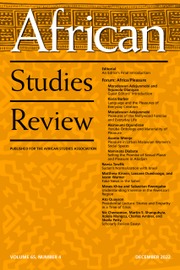In Writing on the Soil: Land and Landscape in Literature from Eastern and Southern Africa, Ng’ang’a Wahu-Mũchiri presents land as a dynamic, living entity that entangles the human and nonhuman. Through close readings of novels, plays, and poetry from the colonial and postindependence eras, as well as theoretical engagements with ecofeminist and decolonial frameworks, he challenges Western rationalism and repositions land as an active agent in political struggles, identity construction, and belonging. The book’s five chapters integrate personal history as a framing device and explore the narrative techniques African authors deploy to interrogate and decenter Western epistemologies.
The first chapter introduces the concept of mystical realism as a decolonial narrative technique that foregrounds the landscape as a contested site where different epistemologies and ontologies interact. Through an analysis of Grace Ogot’s The Promised Land and Margaret Ogola’s The River and the Source, Wahu-Mũchiri examines the contradictions inherent in depictions of land in Kenyan literature. He critiques Ogot for reinforcing an anthropocentric and utilitarian view of land despite her subversive use of Western biblical narratives to reframe indigenous presence. Ogola, on the other hand, he argues, employs Indigenous spirituality and folklore to challenge colonial ontologies and resist dominant narratives of land ownership but also subsumes Indigenous cultural distinctions under the homogenizing category of Black.
The second chapter demonstrates how Yvonne Vera’s and Alex Kanengoni’s stylistic choices reimagine land as a space of alternative belonging and as a sentient entity that rejects extractive and possessive relationships in favor of a custodial and reciprocal dynamic. Wahu-Mũchiri argues that both authors use mystical realism to dissolve the boundaries between the spiritual and material worlds. He highlights Vera’s polyphonic narrative style, which inclusively captures the collective consciousness of entire communities, and Kanengoni’s use of trauma as a metaphor inscribed onto the landscape. In the third chapter, Wahu-Mũchiri turns to urban spaces by examining how marginalized and displaced individuals reclaim agency in structurally exclusionary environments. Through a close reading of Marjorie Macgoye’s Coming to Birth and M.G. Vassanji’s Uhuru Street, he argues that urban landscapes become sites of performative acts of belonging, where characters transgress imposed boundaries and assert newly formed cultural subjectivities. This chapter extends previous scholarship on African urbanism by illustrating how city spaces are lived environments as well as sites of cultural production.
The fourth chapter shifts focus to Ethiopian and Tanzanian literature. It emphasizes the role of indigenous languages in reframing representations of land. Here, Wahu-Mũchiri examines how Ebrahim Hussein and Sahle Selassie, who have both written in African languages, reposition indigenous languages as key reservoirs of ecological knowledge while also reclaiming in their texts allegories of lands from the control of central governments. The discussion of language politics in this chapter is a crucial intervention that highlights the need for more critical scholarship on how linguistic choices influence ecological and spatial representations. Wahu-Mũchiri further expounds on this argument in the book’s coda, where he claims that literature written in African languages will not only attract a wider “African audience” but also challenge the dominance of English and French in academic discourse on African ecologies and facilitate a better understanding of the very ontologies in which these novels are set.
The fifth and final chapter of the book explores the intersection of gender, trauma, and landscape, arguing that narratives of gendered violence often accompany representations of environmental ruin. Wahu-Mũchiri analyzes Monica Nyeko’s use of food metaphors to link ecological destruction with broader forms of social dispossession and altered psychic states. This chapter strongly critiques nationalist pastoral narratives that romanticize rural life while erasing its political complexity. Wahu-Mũchiri shows that Nyeko’s centering of love in rural contexts, as well as the intertwinement of human characters’ lives with the landscape and the nonhuman in Yvonne Owuor’s Dust, push against dichotomies between rural and urban spaces, life and death, nature and culture. His argument that these texts, alongside the ones analyzed in previous chapters, reject the bifurcated worldview imposed by Western ontologies through imperialism is one of the book’s most compelling contributions.
The book has notable weaknesses. Wahu-Mũchiri’s critique of Enlightenment rationalism, while important, sometimes oversimplifies how African writers engage with its ideas. His reading of Ogot, for example, fails to acknowledge how her reappropriation of biblical narratives might complicate a strictly anthropocentric or utilitarian view of land in a modern context. Rather than merely replicating colonial ideologies, Ogot’s narrative could be read as negotiating modernity on its own terms through an incorporation of Christian spiritual frameworks into an already existing indigenous system of knowledge and beliefs. Ogot’s perspective aligns with that of the former Zambian president and philosopher Kenneth Kaunda, who, in his thought, attempted to reconcile modern political philosophy with ethics and sensibilities of the nonhuman. By invoking concepts such as “colonial citizenship,” “Western modernity”, and “Pre-European African societies,” Wahu-Mũchiri not only overstates European colonialism in Africa’s history but also positions the characters he analyzes within an analytical framework that often casts them as products of colonial history rather than architects of their own history and modernities. Nevertheless, Wahu-Mũchiri’s book presents an important corrective to existing scholarship that has overlooked landscapes and the nonhuman in postcolonial ecocriticism.


